In the early to mid-1800s, large companies and wealthy businessmen were looking for the best way to get goods and materials to market. In many places, the owners of the newly emerging railroads were winning the battle to show that they offered a faster and more direct method than
the existing canal systems.
Not so much in Franconia Township. Here in the rural northern part of Montgomery and Bucks counties, the main concern of most people was farming. There were also tradesmen, of course – blacksmiths, wagon builders and wheelwrights, builders and carpenters. But for most, the existing methods for getting their products where they needed to go were working fine.

The slight curve shows where the line was diverted in Henry Souder’s favor.
Then one lumberman, Henry Oberholtzer Souder, heard about a proposed railroad that would take advantage of the new coal fields around Mauch Chunk — now known as Jim Thorpe — and the upper Lehigh County area. This railroad was designed to parallel Bethlehem Pike from Philadelphia to the Lehigh Valley.
Henry thought rail transport might be an improvement over taking a team of oxen more than 20 miles on rough roads to Point Pleasant to secure his lumber supply from the Delaware Canal boats.
So, he contacted the Philadelphia, Easton, and Water Gap Railroad with a proposal. He would provide free land for the railroad – and his home for an office — if they would slightly divert the planned route to his corner of Franconia Township.
The railroad agreed to Henry’s idea, and construction began in June 1853. Later that year, in October, the name of the line was changed to the North Pennsylvania Railroad. The same year also saw the early stages of the Landis Ridge tunnel, built in nearby Perkasie. Business on the North Penn line
began in 1855, and the first trains rolled into our area in late 1856. The line was completed to South Bethlehem in July 1857.
In hindsight, saying that the railroad played an important part in the history of our towns could not be more of an understatement!
Souderton, Telford, and many other places along “The North Penn” may never have existed if it wasn’t for this confluence of events. The trains brought business and tourism, which only increased after 1879, when the Philadelphia & Reading Railroad (the “P&R,” predecessor to the famous Reading Company) acquired the North Pennsylvania via a long-term lease.
“Our railroad” became known as the Bethlehem Branch of the P&R. This added 88 miles of track and 56 locomotives to the ever-growing P&R systemWe’re going take a look at some of those early trains as our ancestors would have seen them. But first a quick side note: It would be almost impossible to discuss the railroad history of the Bethlehem Branch without mentioning Dale Woodland. A Souderton resident and a former Pennridge High School. teacher and student advisor, Dale is an author and a widely recognized Reading Railroad enthusiast and expert. Many of the photos here were taken or owned by Dale, and we are grateful for his support and contributions to railroad history, both locally and beyond!

Above: Two examples of what locomotives may have looked like in the early years of railroads.

The 1850s and 1860s were still pretty early in the history of railroading, especially in the local area. There were even several locomotives on the North Penn called the “Telford,” the “Hatfield,” the “Quakertown,” and the “Perkasie” as well as other nearby place names.
A type of steam locomotive called a “Camelback” ran on the Bethlehem Branch for many decades. Baldwin Locomotive Works of Philadelphia began production in the 1880s and 1890s. The P&R, with workshops in Reading, began production of its own models soon after. The firebox was at the rear, with the cab located in the middle of the engine. They were used for both freight and passenger needs.

The Camelback locomotive was designed with the firebox at the rear and the cab in the middle. Two other examples of Camelbacks are shown below.
The Philadelphia & Reading was one of the first railroads to use this type of locomotive, and it continued to introduce improved varieties of Camelbacks all around its system into the 1940s.

Two examples of what locomotives may have looked like in the early years of railroads.

In 1923, the old “P&R” name on the equipment moving along the tracks became the modern “Reading.” Because of the hilly nature of the northern portion of the Bethlehem Branch, the increasing freight needs, and passenger deadlines, the Reading often upgraded the locomotives used on the Bethlehem Branch.

Top, in Perkasie (Perkasie Historical Society), and bottom, headed into Souderton (Dale Woodland).

As a result, many other types of locomotives made their way through our towns as the Reading tried new technology or shifted the use of existing older technologies.

A G-1sa “Pacific” locomotive passes Moyer & Son, today’s Moyer Indoor Outdoor on Reliance Road. (Dale Woodland photo)
Steam locomotives of various types and sizes were used by the Reading all through the 1940s and into the 1950s. In fact, the last 4-6-2 Pacific type locomotives made in the United States were the Reading G-3 Pacifics.
But by this time, diesel engines were becoming much more established, and the beautiful G-3 models were all scrapped after nine years of service. The era of the diesel had finally taken over the Reading.
One very common early diesel was the Alco RS-3 model. These engines were used around the Reading system for freight and passenger service throughout the 1950s and 1960s.

An Alco RS-3 diesel in Telford; note the three rail tracks. (Mark Frederick photo)
As mentioned earlier, one of the primary reasons the Reading system was formed was to transport coal to Philadelphia, and countless Reading coal trains made their way south through Sellersville and Telford. Equally large freight trains also headed north, with coke and iron ore for the Bethlehem steel works.
In the heyday of railroading, Souderton and Telford saw as many as 50 trains a day pass through. In fact, it became so dangerous that the Broad Street grade crossing in Souderton was closed in 1927, and the Chestnut Street underpass was built to divert traffic around it. There was also a pedestrian tunnel built under the crossing that some residents may still recall fondly. The Broad Street crossing would not reopen again until 1968!

Above: One of the countless Reading coal trains, with a more modern locomotive, makes its way from Sellersville into Telford. Below: The FP7 locomotive used by the Reading railroad for passenger service, seen in Lansdale. (Both photos by Dale Woodland.)

It is interesting to note that in Telford, there were three parallel tracks. The center track was used as a passing siding, interchange, and — in the days of steam — a waiting area for “helper” locomotives, as heavier trains faced the upgrade into Perkasie and West Rockhill Township. There was even a water tower poised alongside the tracks a short distance from the crossing.
Another locomotive popular with rail fans is the EMD F7 diesel. The Reading had a number of F7s in its sheds, including a variation for passenger service. This train used the “push-pull” configuration – one locomotive at each end.
In the early days of SEPTA — formed in1963 — one of these same FP7 passenger trains was painted in a gaudy red, white, and blue scheme — earning it the nickname of “the circus train.”
Alas … all good things come to an end. In July 1981, all passenger service on the Bethlehem Branch was discontinued north of Lansdale. Only the electrified tracks to the south made it into the future. In this late era, the self-propelled RDC — or Rail Diesel Cars — were a common sight on the railroad in our towns. These passenger cars were made by the famous Budd Company, and many are still used today for tourist excursions. As you can see by the autos in the photo at right, the RDCs were in use for many years.

The self-propelled RDC – or Rail Diesel Cars – were a common sight on the railroad in our towns, as here in Souderton. (Heritage Conservancy photo)
Today, some limited freight service continues north as far as the Quakertown area via the East Penn Railroad and Pennsylvania Northeastern Railroad. These two companies exchange their payloads at Telford. North of Quakertown, many of the rail beds have been converted to trails or just removed altogether.
There are many railroad tales still to be told and remembered. Milk trains taking locally produced milk to market. Tobacco products coming in to the local cigar companies and finished cigars heading out to buyers everywhere. The movement of horses, cattle, pigs and goats. The “Dutch Local” freight train moving goods in the Pennsylvania Dutch country between Lansdale and Bethlehem. The express trains heading south to cheer the Phillies. Excursion trains in recent years with many excited rail fans. And even the rare accidents that made headlines.
So, while the rich railroad history in our towns has been gradually forgotten, we can be glad that Henry Souder made a deal with a long-ago railroad — or all our lives could be very different!
****
The Souderton-Telford Historical Society seeks to preserve and share the history of our towns, businesses, and residents. Follow us on Facebook (@SoudertonTelfordHistory) and enjoy posts about local history. Do you have old photographs we can scan for our collection? Or a story to share about growing up in the Souderton-Telford area? We would like to hear from you! Email newsletter@soudertontelfordhistory.org.
The Souderton-Telford Historical Society is a 501(c)(3) non-profit. Your contribution helps to collect, preserve, and share the history of our towns. Tax-deductible donations may be mailed to:
Souderton-Telford Historical Society
127 E. Broad St.
Souderton PA 18964
Or use the DONATE button on our Facebook page.
